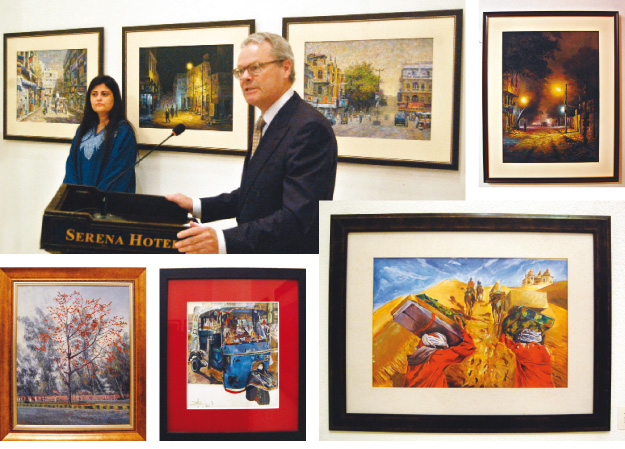
ISLAMABAD:
‘Bend in the Scapes’ at Serena Hotel’s Satrang Gallery exhibits a collection of paintings featuring eight gifted and observant artists, who welcome their viewers into the picturesque worlds they have portrayed.
Imbibing the beauty found in mankind’s natural habitat, peregrinating from the urban to the rural; these paintings thus also lend a visual canvas for social and anthropological analysis. Representing the countryside of far off Sweden to Pakistan’s throbbing city of Karachi, the banks of the River Ravi in historic Lahore, the landscapes of the Punjab and Khyber-Pakhtunkhwa and the people and sights of the Thar Desert, these pieces confer energetic serenity.
Mughees Riaz pays homage to space and natural light in his work. Riaz’s renderings of the River Ravi are beautiful, yet simple and serene. His scenes are devoid of unnecessary objects or figures; Riaz chooses to portray a single buffalo, gypsy hut or crow surrounded by the vivid colours of sunset and dusk. It is the physical space and the light that is his focus; the lit up figure is a conscious addition of the artist, yet is always a bystander or secondary element in the painting. “My work is a simple reflection of my inspiration, I always wanted to amalgamate nature with my feelings,” says Riaz.
Some artists like Abid Khan, Ajab Khan and Mishaal Rinch are interested in rediscovering nature in their art, and examining man’s bond with the environment. Abid Khan tends to paint nature with regard to cityscapes, although his repertoire is widespread. His quick, energetic brushstrokes create compelling scenes of brightly hued trees and snowy populated valleys. His work often includes minute figures. Ajab Khan’s bright colourful pieces are similar, in that they demonstrate man’s impact on the countryside, and utilise a bright lush palette. Ajab Khan’s pieces portray ploughed and tilled fields with streams running through woods. However, both artists differ stylistically. Abid Khan’s brushstrokes are quick, energetic and fairly rough, while Ajab Khan tends to follow a more careful, and realistic approach to his pieces. Mishaal Rinch is a young artist who is exploring cultural scenarios; her depictions of the harvest and busy rural lifestyles contrast sharply with some of her other pieces which deal with city rickshaws.

The most intriguing is Ali Abbas’ work which presents the viewer with glimpses of the life of nomads. PHOTO: MUHAMMAD JAVAID/EXPRESS
Similarly, Raja Najamul Hassan has portrayed fields of bright yellow blooming mustard flowers, a sight that is often seen in the rural countryside of Pakistan. Najamul Hassan’s paintings are composed of bright daubs of colour, effectively conveying the texture and abundance of the blossoms. The artwork of the popular Swedish artist, Ivan Joern, is vibrant and energetic. His renditions of natural surroundings are made more abstract by his vivid colour choices, and the bold outlines that he uses. His pieces convey the vitality of his surroundings, and Joern is able to capture the essence of the scenes he has painted, yet there is a certain foreboding quality or darkness in his depictions which is not present in the work of the other artists.
Perhaps the most intriguing is Ali Abbas’ work which presents the viewer with glimpses of the life of nomads. He paints the nomadic people of the Thar desert. These phenomenal representations often focus on the women of the nomadic community, who are considered the matriarchs of the societal structure. Abbas dulls the background down to neutral colours and brightens the figures in his pieces. The vivid greens, purples and oranges in his compositions draw in the viewer’s gaze, while the perfectly captured expressions and gestures of his subjects keep their attention.
The treasures and hidden secrets of Karachi are revealed in Hanif Shahzad’s interpretations of the city. Shahzad depicts the bustling markets and busy streets of this historic and fast-paced metropolis. Shahzad’s architectural prowess is immediately clear, he has captured the range of styles of Karachi’s construction; whether they are older, traditional and slightly crumbling edifices or modern concrete blocks — although Shahzad tends to paint more of the former in his work. “I was born and brought up in Karachi and have an emotional bond with its historical buildings, which belongs to all kinds of architecture,” he explain.
The exhibition continues till January 8, 2013.
Published in The Express Tribune, December 24th, 2012.
Like Life & Style on Facebook and follow at @ETLifeandStyle for the latest in fashion, gossip, entertainment




























































COMMENTS
Comments are moderated and generally will be posted if they are on-topic and not abusive.
For more information, please see our Comments FAQ